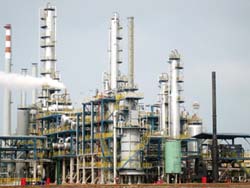
The fluidized catalytic cracking (FCC) dry gas, a by-product of petroleum refineries, contains about 15-20% ethylene, a major raw chemical substance in great demand across the world. It is difficult, however, to separate ethylene from other components of the dry gas. For this reason, about 600,000 tons of such ethylene normally burned off for heat recovery each year in this country.
To exploit the FCC dry gas, researchers from the CAS Dalian Institute for Chemical Physics (DCIP) have developed a new chemical process for production of ethylbenzene that enabled the ethylene sourced from FCC dry gases to react with benzene. The first plant for commercialization of this technology was built in 1993. After that the second and third generation of the FCC dry gas alkylation process was successfully developed in 2001 and 2002, respectively.
On the basis of the third generation technology, named "optimal integration of gas-phase benzene alkylation with ethylene in FCC dry gas and liquid-phase transalkylation," a production installment with an annual capacity of 60,000 tons was put into operation in Jinxi Petroleum Processing and Chemical Complex under the China National Petroleum Corporation. More recently, DICP researchers and their collaborators in China attained a new success. Using this technology, a new production facility with an annual capacity of 80,000 tons constructed at the Shihua-Jiasheng Chemical Co. Ltd. commissioned successfully on Nov. 15. Both the conversion rate of the ethylene and the selectivity to ethylbenzene in the dry gas has exceeded 99%.





